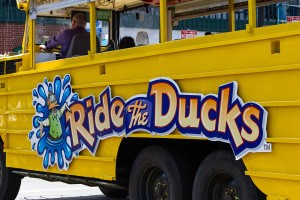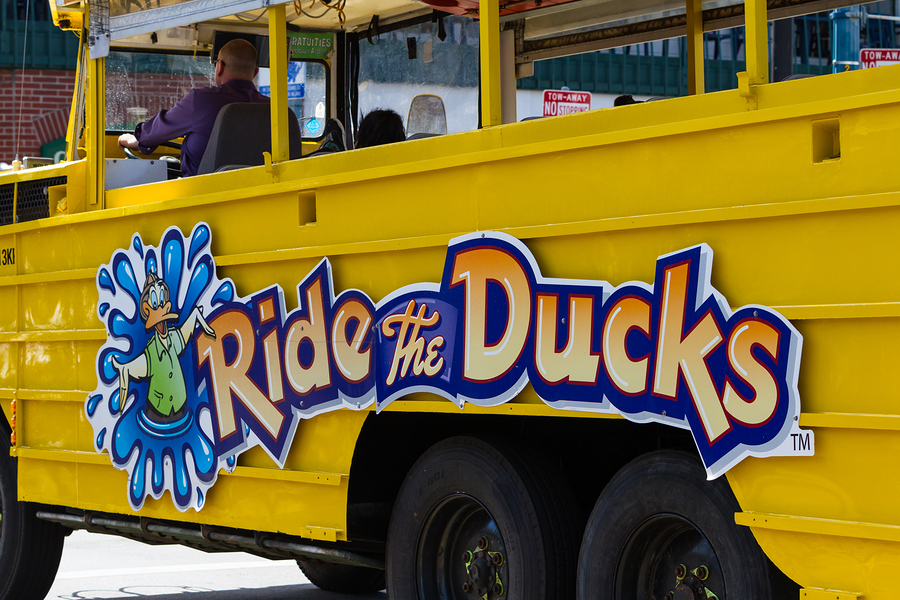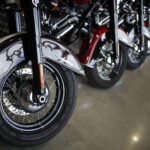The National Transportation Safety Board’s investigation into the deadly crash of a duck boat and charter bus is the first time the agency has looked into a land crash of the amphibious vehicles critics say are too dangerous for city streets.
The agency has scrutinized the military-style vehicles several times when they’ve been in accidents on water, board member Earl Weener said at a news conference Friday.
Four international students died in the crash Thursday after witnesses said the duck boat veered into the oncoming bus on a Seattle bridge.
A team of investigators arrived Friday and will spend a week or more on site. A typical investigation lasts a year, Weener said.
Federal investigators say the left front axle of the duck boat involved in the accident was sheared off, but they don’t know if it was damaged before the collision with a charter bus that killed four international college students.
National Transportation Safety Board Member Earl Weener said Saturday the axle will be sent to a federal lab for further examination.
Weener said it’s too soon to know how the axle was damaged, or if it happened before the collision.
Witnesses have said they saw the duck boat’s left tire “lock up” Thursday as it swerved into a charter bus carrying international students over a bridge.
Four North Seattle College students from Austria, China, Indonesia and Japan were killed.
Even before the crash, calls had emerged for greater oversight and even an outright ban on the military-style vehicles that allow tourists to see cities by road and water.
Critics say the large amphibious vehicles are built for war, not for ferrying people on narrow city streets.
“Duck boats are dangerous on the land and on the water. They shouldn’t be allowed to be used,” Robert Mongeluzzi, a Philadelphia attorney, said Friday, renewing his call for a moratorium on their operation nationwide.
His firm represented the families of victims in a deadly 2010 crash near Philadelphia. A tugboat-guided barge plowed into a duck boat packed with tourists that had stalled in the Delaware River, sinking the boat and killing two Hungarian students.
“They were created to invade a country from the water, not to carry tourists,” said Mongeluzzi, whose firm now represents the family of a woman killed in May by an amphibious vehicle in Philadelphia.
Some attorneys also question the focus of the drivers. In Seattle, tours are complete with exuberant operators who play loud music and quack through speakers.
“This is a business model that requires the driver to be a driver, tour guide and entertainer at the same time,” said Steve Bulzomi, the attorney for a motorcyclist who was run over and dragged by a duck boat that came up behind him at a stoplight in Seattle in 2011.
Brian Tracey, president of Ride the Ducks Seattle, which is independently owned and operated, said Thursday it was too early to speculate about what happened. “We will get to the bottom” of the crash, he said.
Tracey said the captains are certified by the Coast Guard and licensed as commercial drivers, and they are required to take continuing education once a month.
State regulators last conducted a comprehensive safety inspection of the Ride the Ducks fleet, including driver qualifications, employee drug and alcohol testing, in 2012. They issued a satisfactory rating. The company operates 17 amphibious vehicles and employs 35 drivers, according to the state review.
Seattle Mayor Ed Murray said Ride the Ducks Seattle has voluntarily sidelined its vehicles for the time being.
The amphibious boats are remnants from when the U.S. Army deployed thousands of amphibious landing craft during World War II. Once the war was over, some were converted to sightseeing vehicles in U.S. cities.
Ferndale, Washington-based Bellair Charters, which owns the bus involved in the crash, was last inspected by the Federal Motor Carrier Safety Administration in 2013 and received a satisfactory rating, state regulators said.
About 45 students and staff from North Seattle College were traveling Thursday to the city’s iconic Pike Place Market and Safeco Field for orientation events when witnesses said the duck boat suddenly swerved into their oncoming charter bus.
The driver of the charter bus reported that the duck boat “careened” into them on the bridge, Richard Johnson, president of Bellair Charters, said Friday.
Authorities say it’s too soon to determine what caused the crash that killed four students from Austria, China, Indonesia and Japan.
Weener, from the NTSB, said federal authorities’ goal is to prevent future accidents. “We’d like to find out what… the industry can do to make sure it doesn’t happen again,” he said Friday.
Katie Moody, 30, from Fremont, California, was among 36 tourists aboard the duck boat when it crashed. From her hospital bed, where she was recovering from a broken collarbone, she broke into tears Friday as she recounted the accident.
“I just remember it felt like we lost control, and I looked up and saw the bus headed toward us,” Moody said. “Hearing the impact, that was the scariest part.”
(Associated Press writers Gene Johnson, Lisa Baumann, Donna Blankinship and Manuel Valdes contributed to this report.)
Was this article valuable?
Here are more articles you may enjoy.


 NYC Tourist Helicopter Crashes in Hudson River, Killing Six
NYC Tourist Helicopter Crashes in Hudson River, Killing Six  Group Sues California Department of Insurance Over FAIR Plan Surcharges
Group Sues California Department of Insurance Over FAIR Plan Surcharges  EU Adopts Tariffs on $23B Billion of US Goods in Metals Fight
EU Adopts Tariffs on $23B Billion of US Goods in Metals Fight  Inspections of Affected Barrels Will Take Time as Flood Cleanup Progresses at Kentucky Distillery
Inspections of Affected Barrels Will Take Time as Flood Cleanup Progresses at Kentucky Distillery 